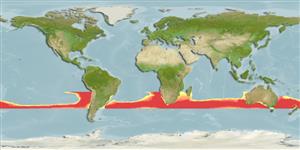>
Stomiiformes (Lightfishes and dragonfishes) >
Stomiidae (Barbeled dragonfishes) > Astronesthinae
Etymology: Astronesthes: Greek, astra = ray + Greek, esthes, -es = suit, something used to wrap (Ref. 45335).
Eponymy: George Albert Boulenger (1858–1937) was a Belgian-British zoologist at the British Museum, London. [...] (Ref. 128868), visit book page.
Environment: milieu / climate zone / rango de profundidad / distribution range
Ecología
marino batipelágico; rango de profundidad 12 - 4000 m (Ref. 34190). Deep-water; 20°S - 40°S
Circumsubtropical 30° and 40°S.
Tamaño / Peso / Age
Madurez: Lm ? range ? - ? cm
Max length : 21.0 cm TL macho / no sexado; (Ref. 34190); 21.2 cm SL (female)
Short description
Claves de identificación | Morfología | Morfometría
Espinas dorsales (total) : 0; Radios blandos dorsales (total) : 13 - 17; Espinas anales: 0; Radios blandos anales: 12 - 18. Black in color with pale luminous patches, which develop with growth, on dorsal and ventral caudal peduncle and other parts of body (Ref. 3982).
Body shape (shape guide): elongated.
Mesopelagic species (Ref. 7300).
Life cycle and mating behavior
Madurez | Reproducción | Puesta | Huevos | Fecundidad | Larva
Gibbs, R.H. Jr., 1986. Astronesthidae. p. 231-234. In M.M. Smith and P.C. Heemstra (eds.) Smiths' sea fishes. Springer-Verlag, Berlin. (Ref. 3982)
IUCN Red List Status (Ref. 130435: Version 2025-1)
Threat to humans
Harmless
Human uses
Herramientas
Special reports
Download XML
Fuentes de Internet
Estimates based on models
Preferred temperature (Referencia
123201): 3 - 8.3, mean 4 °C (based on 422 cells).
Phylogenetic diversity index (Referencia
82804): PD
50 = 0.5000 [Uniqueness, from 0.5 = low to 2.0 = high].
Bayesian length-weight: a=0.00417 (0.00171 - 0.01014), b=3.05 (2.84 - 3.26), in cm total length, based on LWR estimates for this (Sub)family-body shape (Ref.
93245).
Nivel trófico (Referencia
69278): 4.0 ±0.6 se; based on size and trophs of closest relatives
Resiliencia (Referencia
120179): Medio, población duplicada en un tiempo mínimo de 1.4-4.4 años (Preliminary K or Fecundity.).
Fishing Vulnerability (Ref.
59153): Low vulnerability (16 of 100).
🛈
